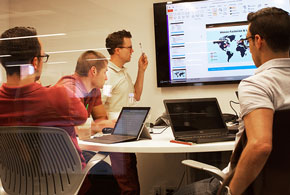Communication and collaboration are at the center of today’s enterprise, but building an effective strategy and putting the right technology and solutions in place can be challenging.
One company that recently addressed this challenge is Mimeo, a privately held firm that handles online managed content distribution and printing for upward of 6,000 companies in 140 countries. “We offer a way for companies to distribute content digitally or through print with a lot of controls over the way they go about it,” Doug Bohaboy, vice president of marketing
During the last couple of years, the New York City-based company has expanded through growth and acquisitions. It now operates offices in New Jersey, Tennessee and Washington state, as well as in the United Kingdom, Germany and India.
“We have expanded greatly,” Bohaboy reports, “and, as our size and scale have increased, the challenges around how we communicate have grown. We have a growing number of remote employees and teams that need to collaborate on projects.”
Further complicating things is the fact that the firm must deal with cross-cultural differences and people scattered across time zones. “There’s a need to operate as a cohesive culture,” he says.
In the past, Mimeo relied on a hodgepodge of communication and collaboration tools, including Skype, GoToMeeting and Google Hangouts. However, the ad hoc approach created practical problems, particularly involving software installation and management.
In some cases, individuals had to install two or three different software tools on their devices in order to get everyone on the same system at the same time. It wasn’t unusual for meetings to start 10 or 15 minutes late.
What’s more, when a problem or support issue arose—which Bohaboy admits happened frequently—IT and help desk staff had to spend time with employees to fix the problem. That added up to between five and 10 hours per month for the IT teams.
Turning to Videoconferencing and Collaboration
“The systems and processes we had in place simply weren’t sustainable,” Bohaboy explains. As a result, Mimeo turned to videoconferencing and collaboration tools from Highfive.
The system went live at the end of 2014, and the firm hasn’t looked back. Today, employees at different locations connect on a dynamic basis. The company has high-definition systems for conference rooms, but staff members can also connect through laptops, tablets and smartphones.
As many as 15 different locations and individuals can participate in any session. The system also provides screen-sharing features and other tools that aid in collaboration. “It has helped us become far more efficient and flexible,” Bohaboy says.
The technology has driven improvements in time and efficiency, and it also has delivered a roughly 60 percent saving over the previous collection of tools. The new system is integrated into Google Calendars, so scheduling a meeting is simple.
“The ability to connect people quickly and easily and have face-to-face communication creates a much stronger and more cohesive culture,” Bohaboy explains. “People are able to pick up nuances and accomplish tasks as though they’re sitting in the same room. They are able to communicate in a stronger and more meaningful way.”
Photo courtesy of Mimeo









